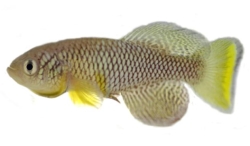Turquoise killifish facts for kids
Quick facts for kids Turquoise killifish |
|
|---|---|
 |
|
| Male Nothobranchius furzeri GRZ (from Gonarezhou National Park) |
|
| Conservation status | |
| Scientific classification |
The turquoise killifish (Nothobranchius furzeri) is a small, colorful fish. It belongs to the killifish family. You can find this fish only in parts of Zimbabwe and Mozambique in Africa. It's a very special fish because of how it lives and grows.
Contents
Meet the Turquoise Killifish
These fish are known as "annual killifish." This means their lives are tied to the seasons. They live in temporary pools of water. These pools are found in dry areas where it doesn't rain much.
The pools fill up during the short rainy season. But they dry out completely when the rain stops. The turquoise killifish has a clever way to survive this. They lay special eggs that can wait in the dry mud. These eggs can stay dormant for a year or even longer. They just wait for the next rains to come.
A Super Fast Life Cycle
The turquoise killifish grows up incredibly fast. They become adults and can have babies just 14 days after they hatch! This is the fastest known maturity for any animal with a backbone.
Because the rainy season is so short, these fish don't live very long in the wild. Most only live for about two months. If they are kept by people, they can live a bit longer. Some can live from 3 to 16 months. This makes them the shortest-lived vertebrate kept in captivity.
Why Are They Important to Science?
Because they have such a short life, turquoise killifish are very important. Scientists use them to study how living things age. They also help researchers understand different diseases.
Scientists are looking closely at their DNA. A big part of their DNA (21%) is made of repeating sections. Researchers think this might be why the fish ages so quickly.
When kept by people, these fish usually eat bloodworms. But scientists are trying to find other foods for them. This helps make sure they stay healthy for studies.
How Big Do They Get?
The turquoise killifish can grow to about 6.5 centimeters long. That's about 2.5 inches.
The name furzeri comes from Richard E. Furzer. He was the person who first discovered this unique fish.


